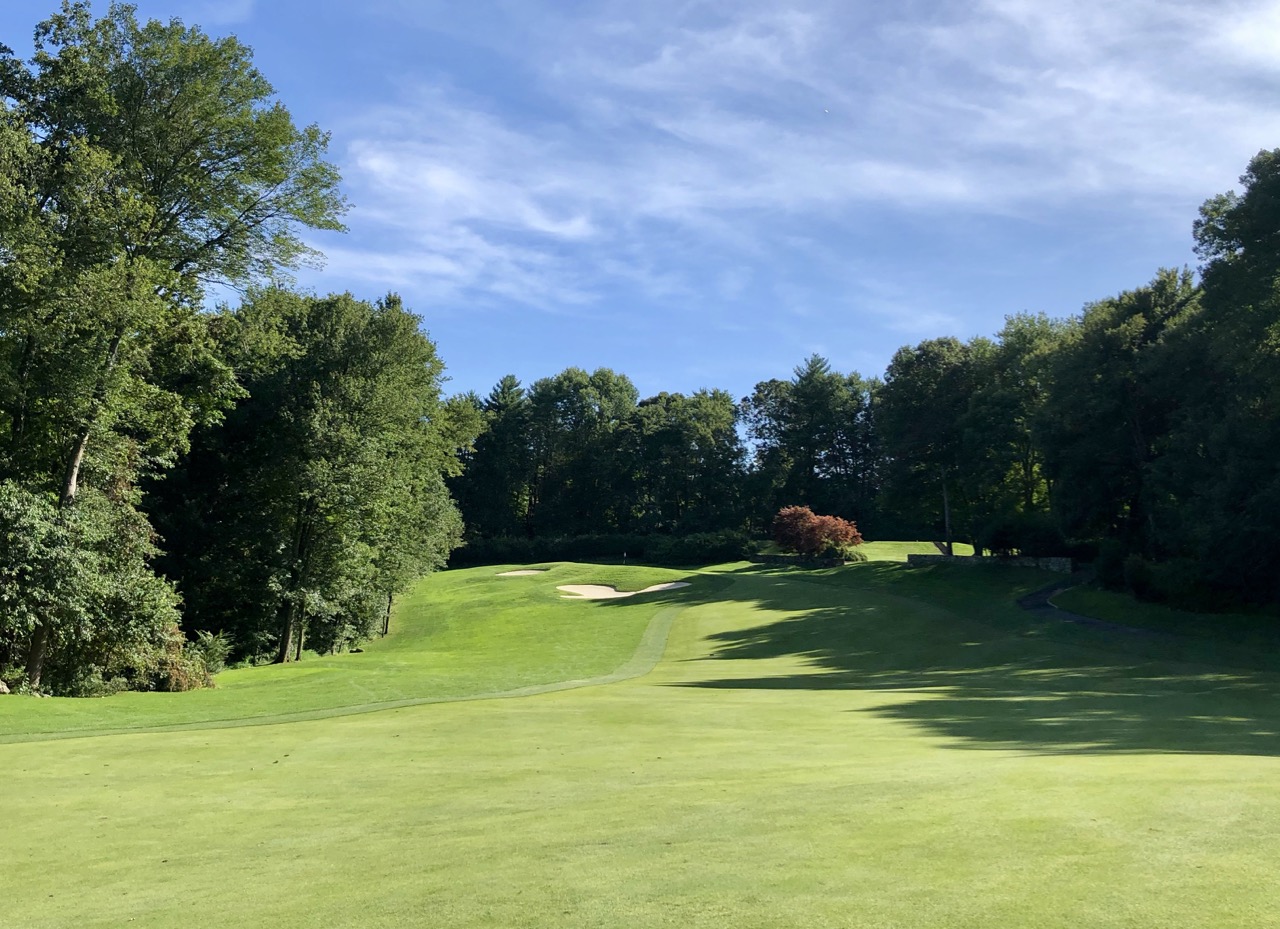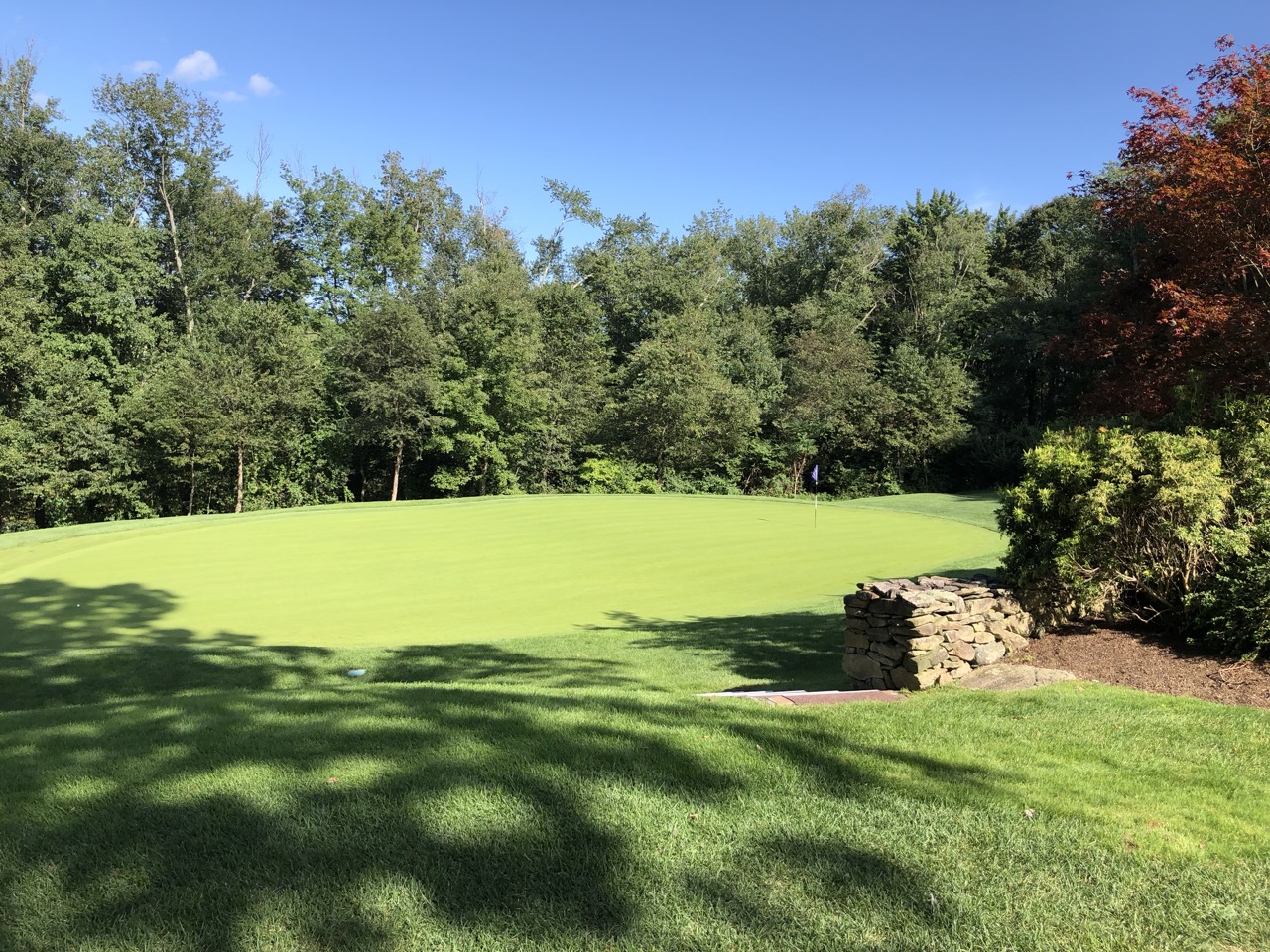Yesterday, I played the private Rockrimmon Country Club course that straddles the border between Connecticut and New York. I don’t know any member there, nor did I talk my way onto the course by promising to publish a review of the Robert Trent Jones layout. (It would have been a strongly positive review.) I played the course with my fellow members of the Junior & Senior Golfing Society of Connecticut, whose members represent many of the more than 75 private clubs in the state.
Over the course of the summer, the Society’s members are invited to play five private golf courses, each round typically preceded by lunch and followed by a dinner at which awards are presented for the best gross and net scores of the day. Yesterday was the one round of the year in which you play your own ball; in the other competitions, you are paired with either your cart mate or your foursome to compete against the rest of the field. Most of Rockrimmon's holes are tree-lined and the turf was in fantastic condition. Robert Trent Jones designed the course with his characteristic bunkering and elevation changes.
Most of Rockrimmon's holes are tree-lined and the turf was in fantastic condition. Robert Trent Jones designed the course with his characteristic bunkering and elevation changes.
Rockrimmon was in almost perfect condition, the smooth greens receptive to well struck shots, a rarity in Connecticut during this fairly dry summer. Playing the course was a privilege and well worth the $230 each member paid (lunch and dinner, one drink and the chance at raffle prizes included). If you are a Connecticut private club member, you are eligible to join the Society; indeed, it is eager for new members.
Other states offer similar opportunities for regular amateur golfers to play some of each state’s finer courses. Golf rating panels are one entry point. I know, for example, that both Carolinas have panels that welcome new members if they play enough of each state’s courses to make meaningful contributions to the annual rankings. Do a Google search using the terms “[Name of state] golf rating panel” to see if your state maintains such a group.
One other way to gain access to the private courses in your area is to donate money to a charity hosting a fund-raising golf event. Many charities, in order to make their events appealing enough to attract $300 or more per donor, will host their events at a high-profile private course. In Connecticut, for example, the Village for Families & Children, a social welfare agency where I have been a board member for more than 12 years, held this year’s outing at TPC River Highlands, site of the annual Traveler’s Championship on the PGA Tour. In previous years, the annual event, which benefits the organization’s fatherhood program, was held at the Willie Park Jr designed Shuttle Meadow.
One other note about these fund-raising events: Many of them use silent auctions as a tool to raise additional funds, and some donors contribute rounds for foursomes at private golf courses. Some years ago, I was able to successfully bid for a round for four at the terrific Yale Golf Club in New Haven, CT. I recall that the price was less than $100 per player, certainly a bargain to play a high-quality golf course I might not otherwise play. The quirkiest hole at the classic Rockrimmon was a short par 4 with a hard left turn in the fairway about 210 yards from the tee box. It forced a fairway wood first shot, leaving a long (175+ yard) approach shot to a severely elevated and well bunkered green. To mitigate the difficulty of the approach shot, the green was the largest on the course. I was happy to two-putt from 70 feet.
The quirkiest hole at the classic Rockrimmon was a short par 4 with a hard left turn in the fairway about 210 yards from the tee box. It forced a fairway wood first shot, leaving a long (175+ yard) approach shot to a severely elevated and well bunkered green. To mitigate the difficulty of the approach shot, the green was the largest on the course. I was happy to two-putt from 70 feet.
I played two rounds of golf recently that put the Bryson Dechambeau pace of play debate in perspective for me. One round I played in 4 ½ hours, the other in just under 4 hours. Ironically, the slower round was better for my golf game.
“How can that be?” I hear all the rabbits out there exclaiming. The answer is simple: It is about pace of play, not speed. (I was tempted to write “It’s the pace of play, stupid,” but I won’t). In my fast round, I played the first six holes with no one in front of me at an average speed per hole of less than 10 minutes. Extrapolate that over all 18 holes, and I would have been in the 19th hole in less than 3 hours. But on the 7th hole, I caught the twosome in front of me; they did not invite me to join them, and I started waiting a minute or two to make my approach shot to the next few greens.
Then, toward the end of the first nine, the twosome caught up to the foursome in front of them. Another single caught up to me as I waited at the 9th tee, and I invited him to join me to play the 9th and the back nine.
Overall, I wound up playing the 18 holes in 4 hours, certainly respectable speed for a mid-morning starting time in perfect weather. But I played at three separate paces – the fast pace of a single, the medium pace of a twosome, and then the slow pace of the foursome two groups ahead – and the erratic pace was not helpful for the pace of my swing which tends to be even more hurried when folks are waiting to hit behind me (which, of course they were because we were waiting for the twosome that was waiting for the foursome in front of them).
Yes, I know, that twosome could have invited us to join them and leavened out the pace of play. But the fact remains that the entire 18 holes would have been played at two or three different paces. Much better was the round I played a few days later on a crowded municipal golf course where everyone in front of us played at a steady 4 ½ hour pace. I never felt rushed to keep up with the group in front or put-upon by the group behind. And I played better shots than I did during my round a few days earlier.
Coincidence? Maybe, but if 4 hours is acceptable to all the rabbits out there who celebrate their speed of play as much as they do their scores, then consider that a 4 ½ hour round is less than 2 minutes per hole longer. And in those 2 minutes, you can contemplate your shot, change your mind about going for a sucker pin position, and otherwise stop and smell the flowers. It will be good for your game and your overall mental health.
Page 62 of 1023























